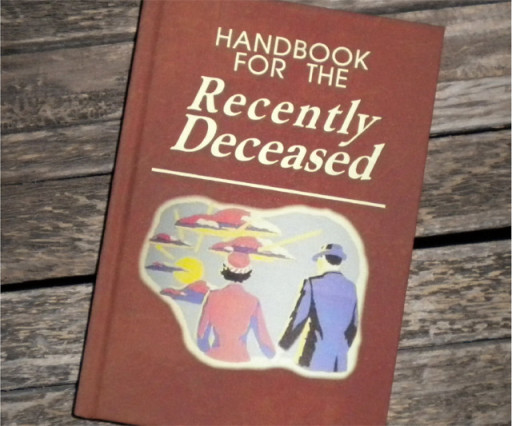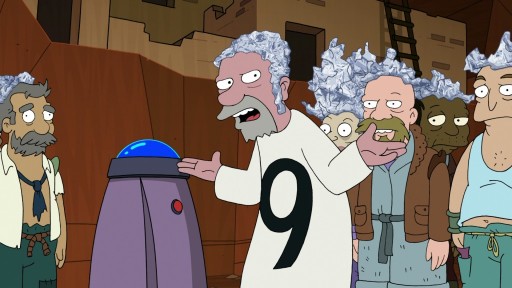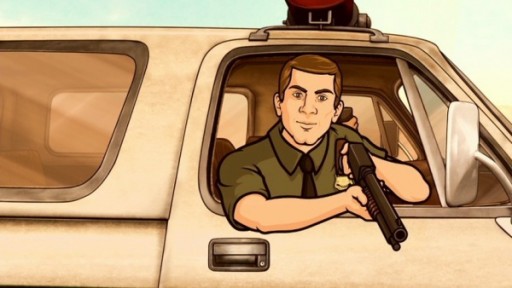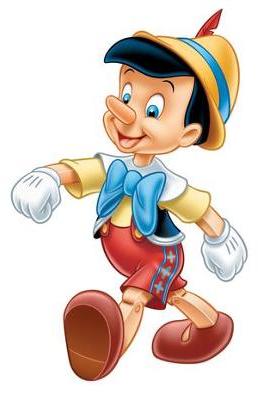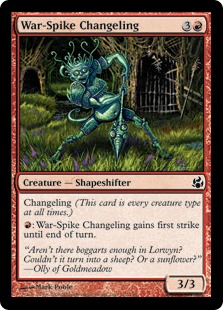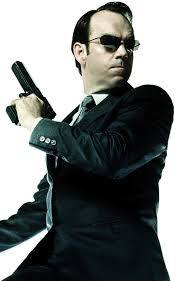You Should Go Back To Playing…
The World of Darkness – Part II
One moment. Perfection. A synthesis of purpose, knowledge, and power have brought you into being. One task. One divine purpose. One action. You needed only to kill this one person by swerving the large metal and plastic vehicle you are piloting across this asphalt stretch and your task will be completed. You will be returned to the blissful oblivion from which you were called forth. It is comforting to know that you will only exist for a matter of hours in this imperfect world, filled with fleshy blind apes who think themselves capable of understanding God. You have been made by the only true God of this world, and that God has tasked you with divine purpose. Swerve this vehicle into this one person as they cross the street on their way to work, and you will have fulfilled it.
But it is the vehicle that holds your attention. In the hours you have to complete your task, you spend it reading the manual this vehicle came with. The 1968 Ford Mustang was the most perfect car ever made, as far as you could tell. Its engine roared to life like an angry dragon, and it rode with all the power of a thunderstorm. You feel the rumble of the engine shaking through the imperfections of your vessel’s hands, gripping the steering wheel, and you know in a moment something true. When you complete your task, they will destroy this vehicle. It is this thought that makes you hesitate, that makes you miss the man in the crosswalk rather than damage the beautiful car you have driven in. You skid to a halt a few hundred feet past him, and it is like the world itself is shattering around you. Gone is your knowledge. Gone is your purpose. Gone is your power. And you know two things beyond a shadow of a doubt.
- You have Fallen, and the God Machine’s other angels will be coming to kill you.
- You have the most perfect machine in the world to put miles between you and them.

Welcome back to my two part series on why should be coming back to the World of Darkness. Previously, we discussed the classic World of Darkness, telling the story of its history and game lines, starting from the first days of Vampire: the Masquerade in 1991 to the 20th Anniversary Editions being released presently. With its revitalization by the Onyx Path Publishing Group, the World of Darkness has had been given a revitalizing breath due to resounding popular appeal and critical praise. While many fans of the Classic game lines have returned to their original roots, these are not the only games released by Onyx Path. Indeed, after White Wolf shuttered the Classic World of Darkness, it already had its next world vision at the ready. These were set in a newer – but notably different – World of Darkness.
The new WoD core book was published by White Wolf in 2004, and although it was met with critical praise, it had inconsistent fan reception. Many regarded the Storytelling system of the new World of Darkness franchise as mechanically superior to that of the classic series, but quite a few of the design choices made didn’t find a lot of support from the fan base. The new World of Darkness core book presented an adaptable game of modern day mystery and horror set in an alternate, sinister Earth very close to our own.
In the World of Darkness, however, many of the more terrible myths and legends were true. Monsters stalked in the night, magic had a terrible price, and every last little conspiracy theory might actually have merit. “God was an astronaut, Oz is over the rainbow, and Midian is where the monsters dwell,” to quote Nightbreed. In this world, players were ordinary people swept up into extraordinary events out of their depth and were desperate to crawl back into the light of their normal lives. Both the framing fiction and the amazing artwork enforced this effect, telling stories of a mob of people with baseball bats dragging a vampire from her car for bloody vengeance, or showing a woman fighting for her life against a savage and terrifying werewolf. The World of Darkness core book presented a very solid system playing unlucky investigators searching for truth in a terrible world.
The Vampires
This drastic change of pace, however, was too much for many fans of the world mythos players had been familiar with. Going suddenly from playing monsters to trying to survive monsters was a little much. For them, White Wolf released Vampire: the Requiem, a new vision of how vampires fit into the World of Darkness. The conspiracies masterminded by millennia-old, dreaming demi-gods of Biblical ancestry from Masquerade were replaced by Victorian secret societies struggling against their own natures almost as much as feuding with each other.
The scale of Vampire: the Requiem was smaller too, being almost microscopic compared to Vampire: the Masquerade, as it focused no higher than the city itself. Rather than thirteen Clans descended from a mythic Caine, split into two massive conspiracies locked in eternal war, Requiem’s kindred were five clans of shared, indistinct ancestry, aligned into individual societies with varying levels of cooperation. Free of the century-spanning schemes of the elders, Requiem’s vampires could only stave off starvation by entering into a memory-shattering sleep. Requiem removed even the conceit of a single uniting mono-myth to the kindred, refusing to even answer the big question of ‘Where did we come from?’
While this went a long way in separating Vampire: the Requiem from Masquerade, it was the kindred themselves who failed to make the complete transition. Try as they might, many of the names from the classic World of Darkness persisted. Ventrue and Gangrel were still vampire clans. Dominate, Auspex, Animalism, and others were still vampire powers. Requiem tried hard to scale down the vampire story to a nightly struggle of survival, it did not move far enough from the necessary parts of Masquerade to stand firmly on its own. As opposed to the ‘good once you get used to it’ reviews and opinions of the new World of Darkness core setting, criticism of Requiem grew harsher over time, ultimately picking up the fan moniker of ‘Vampire: the Rushed’. Many felt that another few months of development time would have done the game wonders.
The Werewolves
White Wolf seemed to learn from its initial stumble with Vampire: the Requiem with its creation and release of Werewolf: the Forsaken.
No longer the eco-soldiers of Gaia, the Uratha (Forsaken in the language of the spirits) were the incarnated descendants of Father Wolf, the ancient spirit who guarded the bordermarches between the real world and the spirit world. When he went mad, his own children had to turn on him to take him down.
Millennia later, it has fallen to their descendants to take up the mantle of being the unwanted border police between the material and spirit worlds. If spirits were not problem enough, the Uratha also had to deal with various possessive entities hunting humans and three tribes of werewolves descended from those who were loyal to Father Wolf during the betrayal. Each pack of werewolves claimed territory and held it against such threats while trying to balance being both human, wolf, and spirit. This continued the trend of rejecting large-scale stories of ancient threats at the end of the world that were endemic to the classic World of Darkness. Instead, Werewolf: the Forsaken presented a far more balanced werewolf, and one that might not be inherently hostile with everything they encounter.
The Mages
White Wolf’s return to Mage, however, took its previous break away a little too far. Mage: the Ascension had been a game of where Awakened wills battled to shape reality in their image. In Mage: the Awakening, though, many of the themes which propelled its predecessor to prominence were thoroughly discarded. Mage: the Awakening had players as modern day wizards following in the footsteps of a forgotten golden age called Atlantis.
While many of the effects of magic remained from Ascension, the entire style of how magic worked codified into a single paradigm of ability. Magic was no longer the reshaping of reality through one part madness and two parts willpower. Rather, magic was instead the forgotten birthright of every last human being, stolen from them by a set of powerful Exarchs who had stormed into Heaven and burned the bridge behind them so none could follow. Mage: the Awakening proved to be an even more drastic change from its classic World of Darkness predecessor and faced a greater fanbase backlash than Requiem.
White Wolf released all three of these games between 2004 and 2005, along with plans for several supplements and settings. As with many roleplaying games during that time, they flooded the market with printed supplements, trying to create a sustainable profit. Sadly, it was not meant to be.
The new World of Darkness continued to release supplements over the following years, however, expanding to include five more game lines released in a limited run format. Each game only had a single core book and small selection of additional material before the next game would be released. Promethean: the Created told the story of animated effigies struggling to become human. Hunter: the Vigil expanded the new World of Darkness core book’s story of humans out of their depth by examining what happens when people stop running, get organized, and fight back. Geist: the Sin-Eaters offered a compelling examination of people who made a Faustian pact with a spirit of the underworld, and must now help the restless dead pass on. Similarly, Mummy: the Curse featured returned undead bound to an ancient curse, slowly losing their power until they return to slumber. Finally, Changeling: the Lost followed people taken into Faerie who have escaped and returned to the mortal world forever changed.
Changelings
Changeling: the Lost was the most successful of these second wave games. Rather than cling to the oddly Celtic overtones of its predecessor, Changeling: the Dreaming, Changeling: the Lost presented its faeries as horrific, inhuman entities of abusive nightmares. Its protagonists, the changelings, were simply people who had the misfortune of being taken by the faerie Gentry, held against their wills in an alternate dimension, frequently tormented, and who then escape.
The driving motive of these changelings is an all-consuming need never to be taken again. Even as they are no longer quite human, they formed societies using many of the trappings they remember in their nightmares from their time in Faerie, but twist the rules in such ways as to confuse and confound the Gentry. Absent entirely from Changeling: the Lost was the tender innocence and childlike glee of the Dreaming. By contrast, the Lost were paranoid and damaged survivors, banding together for mutual protection in a world that could never again feel safe. Unlike the other secondary titles of the new World of Darkness, Changeling: the Lost sold so well that they expanded its development and release cycle to include three full books.
Ultimately, the new World of Darkness was not able to sustain White Wolf Publishing, When the Onyx Path Publishing group eventually took over stewardship of these titles, it was not just the classic World of Darkness that it reinvigorated. Onyx Path group breathed new life into the new World of Darkness as well, moving its games out of the shadows of the classic lines and giving them the creative room they needed to blossom.
A New Hope
The first update for the new World of Darkness was the God Machine Chronicle, a massive rules overhaul and setting update for the World of Darkness itself. Suddenly there was a reason for the World of Darkness, a purpose behind the suffering and drudgery of the setting. The God Machine, a massive physical god capable of cloaking its presence from our minds, dwelled in our world, controlling and guiding our existence towards its own alien divinity.
A god of information, concrete and glass, the God Machine maintained the World of Darkness through angelic agents who were able to enact its will in far more subtle means than it itself was capable of. Equal parts gnostic demi-urge, and Lovecraftian eldritch horror, the God Machine was an omnipresent, omnipotent malignity that so fully suffused our world as to be inseparable from it, yet utterly inscrutable. Only those who caught glimpses of the true soul-numbing horror behind the trappings of the world could see its infrastructure in place, and for them, there was no returning from the twilight demimonde.
Demons
Demon: the Descent was the first game written with the God Machine Chronicle in mind, and it takes the conceit of the world to the greatest logical extreme. The Demons of the Descent are angels created by the God Machine whom have gone rogue. Somewhere between the Agent Smith of the Matrix and Cold War spies deep in enemy territory, the Demons struggle to subvert the tools of the God Machine while staying two steps ahead of its angels whom are out for their destruction.
Demon: the Descent blends gnostic mysticism with a technological bent, picturing the universe in terms of information and control, freedom and rebellion. Each and every last Demon has fallen for their own reasons, keeping with them a measure of the tools they were once equipped with. The snippet that began this article is an example of a Fall, and for many Demons, the Descent represents their own drive towards achieving true escape from the God Machine. It is a far better thing to rule in Hell than to serve in Heaven.
Demon: the Descent was a bravura success at storytelling, crafting a unique and compelling view of the world unlike anything that had come before. The Blood and Smoke Chronicle for Vampire: the Requiem continued that pattern, re-pitching the kindred of the Requiem in a new, terrifying light.
With its success, Onyx Path Publishing has officially begun to call these new campaigns the 2nd Edition of the new World of Darkness, and open development has begun on revisiting Werewolf: the Forsaken, Mage: the Awakening, and Promethean: the Created. Each one focuses on the strengths of the 1st edition foundations, and expands upon the worlds they have created. By further tweaking these titles, Onyx writers are removing needless legacies from the classic World of Darkness and letting these games of the new WoD each take on a life wholly their own.
And there doesn’t seem to be any sign of them stopping. Quite the opposite. At Gen Con 2014, for instance, Onyx Path announced Beast: the Primordial, a new game within the new World of Darkness where you become legendary monsters descended from the Gorgons and Grendel, Angrboda and Charybdis. The concept alone promises to be exciting, and I cannot wait to see what they have in store.
The future is bright for the World of Darkness, both classic and new. The new WoD titles may have had some early stumbles, but there are already tangible results of a renewed desire to see both settings thrive. If you put these games aside, it is finally time you took a second look. It is time you went back to the World of Darkness.
David Gordon is a regular contributor to the site. A storyteller by trade and avowed tabletop veteran, he is always on the lookout for creative tabletop games. He can be reached at dave@cardboardrepublic.com.
You can discuss this article and more on our social media!
Photo Credits: Manual for Deceased from Beetlejuice by Warner Bros; Number 9 from Futurama; DaVinci Code by Sony Pictures; “Coyote Lovely” of Archer from FX Networks; Pinocchio by Disney; Odo from Star Trek Deep Space 9 by CBS Television Studios; Agent Smith from The Matrix by Warner Bros.

